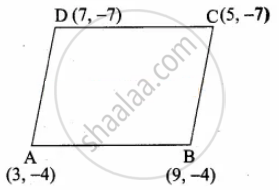Advertisements
Advertisements
प्रश्न
Let A(3, – 4), B(9, – 4), C(5, – 7) and D(7, – 7). Show that ABCD is a trapezium.
उत्तर
Let A(3, – 4), B(9, – 4), C(5, – 7) and D(7, – 7) are the vertices of a quadrilateral.
Slope of a line = `(y_2 - y_1)/(x_2 - x_1)`
Slope of AB = `(-4 + 4)/(9 - 3) = 0/6`= 0
Slope of BC = `(-7 + 4)/(5 -9)= (-3)/(-4) = 3/4`
Slope of CD = `(-7 + 7)/(7 - 5) = 0/2` = 0
Slope of AD = `(-7 + 4)/(7 - 3) = (-3)/4 = - 3/4`
The slope of AB and CD are equal.
∴ AB is parallel to CD. Similarly, the slope of AD and BC are not equal.
∴ AD and BC are not parallel.
∴ The Quadrilateral ABCD is a trapezium.
APPEARS IN
संबंधित प्रश्न
What is the slope of a line whose inclination with positive direction of x-axis is 90°
What is the slope of a line whose inclination with positive direction of x-axis is 0°
What is the inclination of a line whose slope is 0
What is the inclination of a line whose slope is 1
If the three points (3, – 1), (a, 3) and (1, – 3) are collinear, find the value of a
The line through the points (– 2, 6) and (4, 8) is perpendicular to the line through the points (8, 12) and (x, 24). Find the value of x.
A quadrilateral has vertices at A(– 4, – 2), B(5, – 1), C(6, 5) and D(– 7, 6). Show that the mid-points of its sides form a parallelogram.
The slope of the line joining (12, 3), (4, a) is `1/8`. The value of ‘a’ is
The slope of the line which is perpendicular to a line joining the points (0, 0) and (− 8, 8) is
Without using distance formula, show that the points (−2, −1), (4, 0), (3, 3) and (−3, 2) are vertices of a parallelogram
